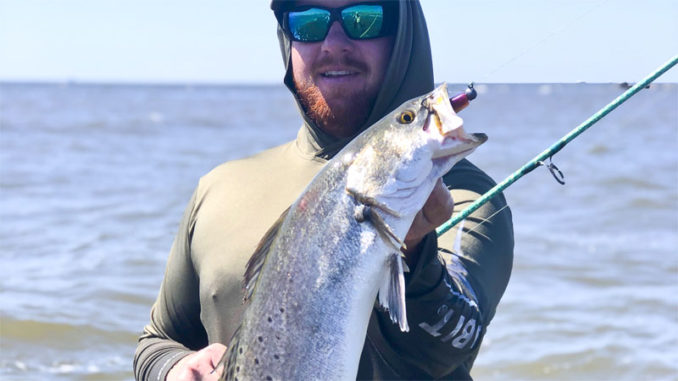
The relative lack of trophy sized specks in Louisiana waters over the past handful of years has fishermen asking questions about the future of those big fish. Here are some answers and theories.
It seems as if the era of trophy speckled trout in Louisiana has ended, and many anglers are wondering if it will ever return.
The Louisiana Department of Wildlife and Fisheries’ 2019 Assessment of Spotted Seatrout in Louisiana Waters showed through landing data and gill-net sampling, the number of speckled trout 3 years of age and older has been dropping and is at a shockingly low 6% of the total trout population.
For a speckled trout to reach trophy size, it needs to survive for 10 years, give or take a few, so the young age of the population cuts “big” out of the vocabulary of trout descriptors. But is that the whole story of why the catches of big trout have been down lately?
There are good reasons to think big trout should live in Louisiana waters. There is as much bait or more in Louisiana than in Florida or Texas, both trophy trout spots. In 2016, shrimpers harvested 102.5 million pounds of shrimp in Louisiana and 20.8 million pounds in Florida. Louisiana also has a higher trout spawning stock biomass (SSB) than Florida or Texas, and Louisiana has more fresh and saltwater marsh than either. So, before hope is lost, it’s worth the time to discover what it takes for speckled trout to live a long life and what that life is like.
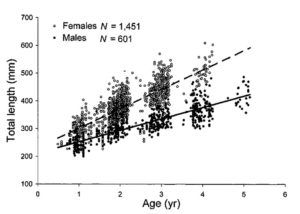 Florida’s hold on records
Florida’s hold on records
Florida is an interesting case study on record-sized speckled trout. It owns 72 of the 100 IGFA records for speckled trout, and 45% of these are clustered around a 100-mile stretch of coast, with Cape Canaveral at the center.
To protect the Canaveral space port, Merritt Island National Wildlife Refuge was created in 1962, and two areas in the refuge are No-Take Reserves: Banana Creek and North Banana River, which cover 15.4 square miles, 22% of the MINWR.
A fisheries researcher, James Bohnsack, conducted a study comparing the presence of Marine Protected Areas (MPAs) in Florida and the record-book catches of speckled trout, red drum, black drum and snook. He found a correlation between MPAs that had No-Take Reserves and IGFA records. He found that 74% of the state records for those species were clustered in two areas equalling just 20% of the Florida coastline, surprising because many other areas have equally adequate habitat and have MPAs.
Each of the sections of record-breaking coastline includes at least one NTR. Two are at Cape Canaveral, and the Everglades National Park (ENP) has one. While there are different explanations for why these sections of coastline produce the most big fish, Bohnsack believes that the simplest explanation is that NTRs result in greater numbers of fish, increased individual survival and greater individual growth, and these results spill over into surrounding waters. This spillover is documented by recapture of fish outside the NTR that were tagged inside it. By contrast, there is no correlation between record-sized fish and coastlines with MPAs that are by state creel and minimum length limits.
There is certainly room for argument that other factors can contribute to the correlation between record-sized fish and NTRs, but the presence of an NTR where fish survival is greatly increased is consistent with the mathematical relationship between length and lifespan. Even a fish that spends a portion of its life inside the NTR before capture outside has a greater advantage to reach trophy size.
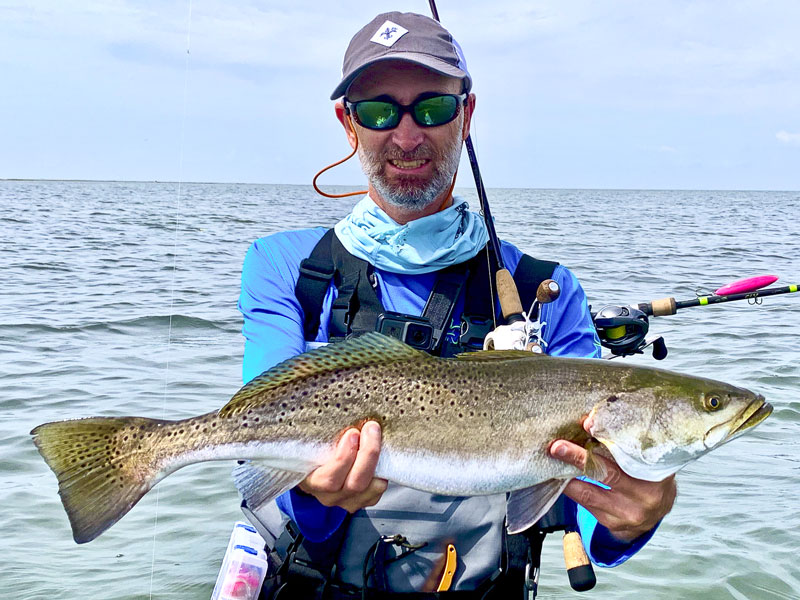
Growth factors
There is a range in the length of speckled trout for a given age-class, as a chart of speckled trout captured in Barataria Bay and reported by David L. Nieland. For example, 4-year-old trout were recorded from 400 to 600 mm (16 to 24 inches) However, each year of life for a trout results in some length gain, and therefore, the survival rate of a speckled trout is directly proportional to the size of the fish.
While genetics may play a role, fish growth is strongly related to the amount of available food that can be efficiently captured. When food is scarce, trout must exert more energy to feed compared to fish living where food is plentiful. Because of the relationship between age and length, a trout that experiences a year of scarcity will never recover the growth it loses. Therefore, we can expect to see larger trout where food is plentiful, and that would be the case within an NTR. It was found that the biodiversity in the Banana River NTR was twice as high as the biodiversity in the waters outside the NTR, and biodiversity is an indicator of the abundance of life in the food chain.
A reduction of biodiversity will negatively affect the species targeted by anglers, such as can happen through habitat loss and commercial overfishing of species such as menhaden and shrimp. The Speckled Truth podcast interviewed Angelos Apeitos, a biologist from Gulf Coast Research Institute who studies speckled trout growth and reproduction. Angelos said that speckled trout will choose to increase their intake of shrimp during the prespawn and spawning periods; this is believed to be a nutritional choice. For example, if shrimp numbers are down due to overfishing or another environmental effect, it’s logical to wonder if the diet of speckled trout will support their full spawning potential for that season. A reduction in the spawn means a reduction in the stock, and that lowers the chance that some trout will survive to trophy size.
Balance: salinity & safety
If there is an abundance of food, strong recruitment (trout less than 1 year old), and adequate habitat, what can explain the lower numbers of large trout being caught in Louisiana compared with Florida and Texas?
Predation needs to be considered as a factor in the development of trophy sized trout. LDWF uses a survival number of 30% per year for speckled trout when modeling the stock. Therefore, the mathematical relationship dictates that there is less than a 1% chance for a 12-inch trout surviving until it reaches 10 years of age. However, it seems clear that the survival rate must increase with age because there are fewer predators capable of eating a trout more than 5 years old, and large trout are more cautious around human activity, which will reduce the chance of being harvested by an angler. An increased survival rate with age can explain why we catch trout older than 5 years.
The need for a long life span suggests that water less frequented by large predators, such as sharks, provides greater possibility of a longer life span for speckled trout. The shallow, big-trout waters around Cape Canaveral and the inshore waters of the lower Texas coast certainly have sharks, but do they have many large sharks? Biologists say the typical habitat for large sharks is the beach and offshore waters, so these shallow areas in Florida and Texas are safer for trout.
There is also a general agreement that trophy sized speckled trout prefer to remain in water of higher salinity. The salinity in the waters around Cape Canaveral and the Texas coast are high compared to similarly protected waters in Louisiana. Areas such as Indian River Lagoon and Laguna Madre consistently see salinity above 15 parts per thousand (ppt) and often greater than 30 ppt, so there is no reason for specks to leave the safer, inshore waters.
By comparison, in the past 5 years, salinity greater than 15 ppt in southeast and central coastal Louisiana is found only along the inner edges of the sounds, the lower regions of bays, the barrier islands, and at nearshore rigs where speckled trout are sometimes found. These waters overlap with the habitat of large sharks, and in fact, some of the best areas for catching larger speckled trout are the surf side of Grand Isle, Elmer’s Island and Timbalier Island, which plants speckled trout in the house of the sharks. Having your speckled trout bit in half by a shark in Louisiana is so common that anglers refer to these events as a visit from the “tax man.”
So if the preferred habitat for trout older than 5 years places them in areas less protected from oil spills, storms, commercial fishing and large predictors than the marshes where they spend the first years of their lives, this could have the effect of shortening life spans. It also needs to be recognized that these areas are more difficult for anglers to access and to fish, so there may be somewhat of a negative bias affecting the numbers of big trout documented in Louisiana by anglers. If life span is the major barrier, is there a historical example of when high salinity and protection converged?
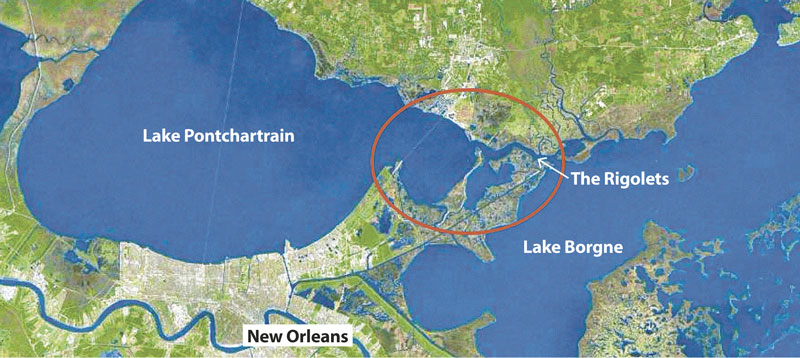 Pontchartrain’s trophy era
Pontchartrain’s trophy era
Lake Pontchartrain experienced a big-trout period from the late 1990s to roughly 2011, a period of higher lake salinity due to inflow of seawater from the MRGO and no high-water Mississippi River events. The Bonnet Carré Spillway was not opened between 1998 and 2008, and seawater flow up the MRGO was not restricted until after 2009. During this period, Louisiana’s No. 2 trout, an 11.99-pound giant, was caught from Ponchartrain by Kenneth Kreeger in January 1999; Louisiana’s No. 3 trout, at 11.24 pounds, was caught in the nearby Rigolets Channel by Jason Trouillier in September 1999, and Louisiana’s No. 10 trout, at 10.50 pounds, was caught by Dudley Vandenborre in April 2002. It’s reasonable to view the geographical position of the lake as protective, so that when suitable conditions developed for big-trout habitat, Ponchartrain became the theater that housed the show. In 2020, the places where suitable conditions intersect do not have the same level of safety from predation, poor water quality, and other environmental factors.
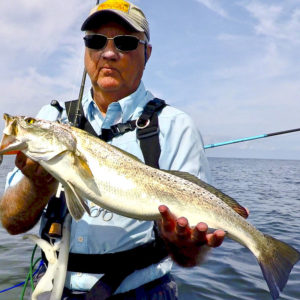
How many big trout?
Ever wondered how many large trout live in Louisiana waters? With a conceptional model, you can get an idea. The key assumption is there is a 1% chance a 1-year-old trout will live to be 10 years old, based on LDWF’s 30% annual survival rate for the spawning stock biomass. Then, add a bias for older trout having a higher survival rate due to fewer predators. The current SSB sits at around 3.5 million pounds, and the 2019 trout assessment said that in 2018, 75% of the SSB was 1-year-old and 95% was 2 years old or younger. Using comparison data from the Gulf Coast Research Institute, we can assume that the average weight of a female trout in Louisiana is currently 0.75 pounds. When we divide 3.5 million pounds by 0.75 pounds per fish, we get a total of 4.7 million fish. If 1% reach trophy size, that is 4,700 fish. When the SSB was at 9 million pounds in 2008, 1% survival equals 12,000 fish reaching trophy size, which is a considerable difference.
How do these numbers relate to the likelihood of being within casting distance of a trophy trout? According to the Nature Conservatory, Louisiana has 10,700 square miles of coastal marshes, and assuming that only 25% is suitable habitat for large speckled trout, that is 2,700 square miles. Evenly spreading large trout over this area, it equals 1.8 large trout per square mile. The area that can be covered by an angler from a single point is only 2.5% of a square mile, so good luck fishing a square mile of water. Of course, spreading the trout equally across every square mile of water is not the best assumption, since we know not every piece of water will hold a large trout. Still, it gives us an idea of how infrequently we may be within casting distance of a trophy trout, and how important it will be to understand where they might be so the odds are improved.
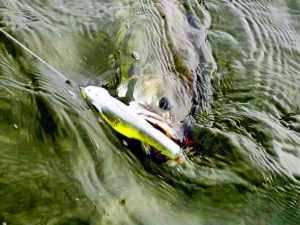
The Louisiana situation
So are big trout still in Louisiana waters in 2020? There has been positive news this year related to bigger trout. Chris Berzas reported a slight rebound in large trout coming from Calcasieu Lake and Sabine Lake. Carl Vidrine reported recently catching a number of sizable trout around Grand Isle, and an 8-pound trout was caught at the MRGO dam by Ian Kelly.
Some trout must survive to a respectable age in Louisiana waters, and the fact that so few are caught is more related to angler habits than a complete lack of big trout. I am reminded of a video taken in 2017 on Mississippi’s Cat Island that caused a tremendous uproar from anglers. It showed a commercial fishing net pulled up onto the island beach, and struggling in the mass of fish were what appeared to be multiple trophy sized trout. That area is not widely known for trophy sized trout, even though it’s fished heavily, but there they were. Therefore, relying on recreational landings to determine how many large trout exist in Louisiana is likely to bias the numbers to the low side.
Most anglers in Louisiana are not fishing for trophy trout, and therefore, they rarely catch trophy trout. The most commonly used bait is live shrimp, which big trout may on occasion consume, but the primary food for big trout are finfish such as menhaden, mullet and croakers. Likewise, anglers typically fish where they are catching good numbers of legal-sized trout. If an angler is catching 13-inch trout nearly every cast, there is little chance of the next one being a 10-pound gator. Last, since most anglers are not targeting big trout, they are not concerned with stealth, and therefore, many unnatural sounds are transmitted into the water that trophy trout anglers consider detrimental, especially for big trout in shallow water.
The continuing barrier island restoration projects give hope for the survival of more large trout in Louisiana, because these structures provide habitat and cover in zones suitable for trophy trout. As well, changes to stock management that results in an increase in female trout will directly improve the possibility of more trout reaching true trophy size.


